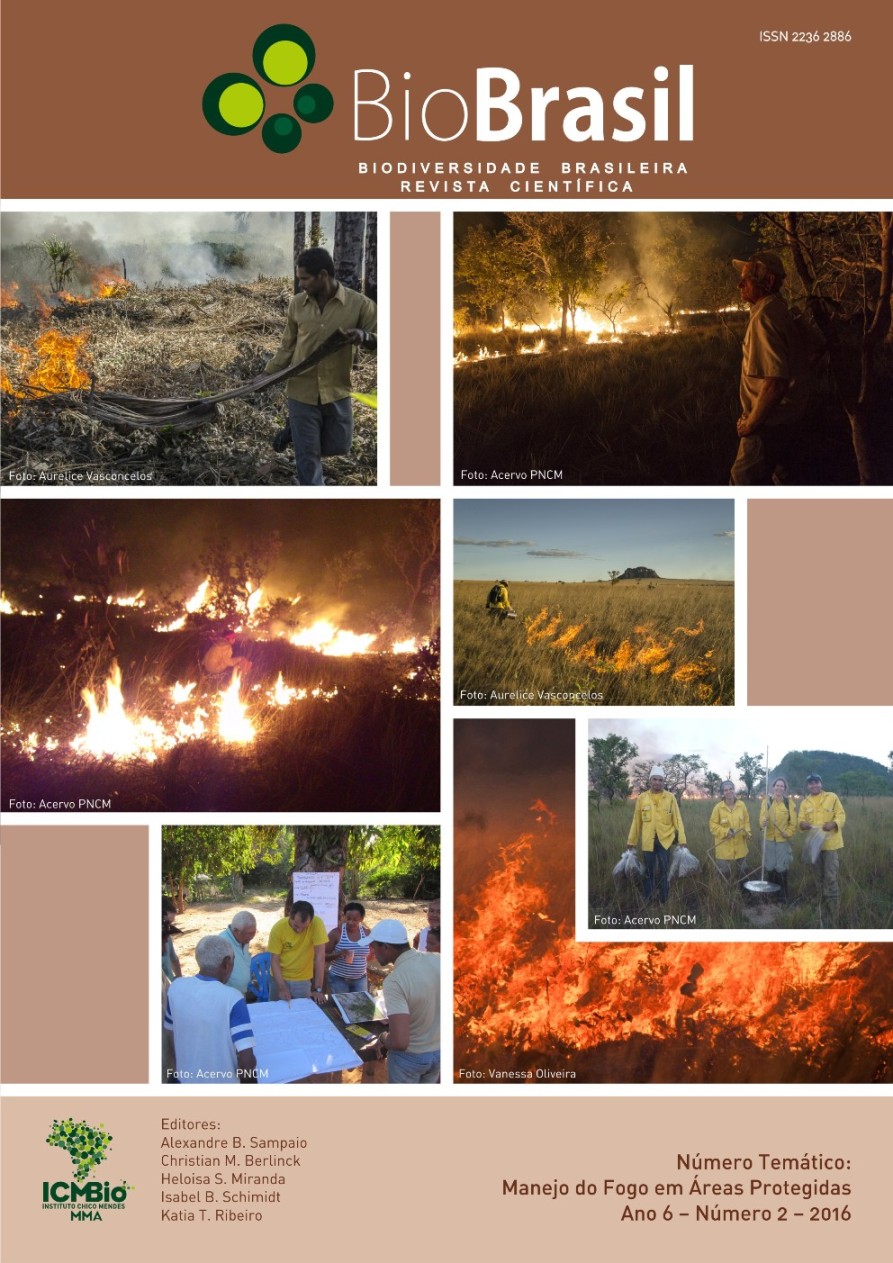Estratégias de integração entre pesquisa e manejo do fogo no Parque Nacional da Serra da Canastra como parte do desenvolvimento de um Programa de Manejo Integrado do fogo
DOI:
https://doi.org/10.37002/biodiversidadebrasileira.v6i2.524Keywords:
Arson, Cerrado biome, grassland ecosystemsAbstract
The Serra da Canastra National Park (SCNP) is one of the most threatened Conservation
Unit (CU) in Brazil due to high frequency of criminal fires (arson). The criminal actions of arsonists were
pointed as the main cause. Although prevention actions and direct fight against fire during the burnings
have been applied for years, including the use of prescribed fires to create firebreaks, costs are expensive,
in many situations the results are not as well as expected, and fire can reach large proportions, threatening
biodiversity. Given this problematic, it was created by environmental analysts of this CU in a partnership
with researchers from universities, a project for the development of an Integrated Fire-Management Program,
whose goals were to examine the history of fire in SCNP; monitoring natural fires and anthropogenic (criminal
and prescribed) burnings; integrate the knowledge produced and published by all the researchers who have developed research in SCNP; investigate the response of local biota to the occurrence of fires, and finally,
share the knowledge and involve the human communities in management actions thread. In this paper, we
present a report of the established strategies and procedures followed for the achievement of some goals, and
some commented results, such as the production of a database drawn from literature review on the effects
of fire on wildlife and flora in grassland and savannas of Brazil, the generation of maps and a database of
images during burnings in 2014 and previous years, the development of academic research and activities
with the local population
References
Anderson, A.B. & Posey, D.A. 1985. Manejo de cerrado pelos índios Kayapó. Boletim do Museu Paraense Emilio Goeldi Botânica, 2(1): 77-98.
Bencke, G.A.; Maurício, G.N.; Develey P.F. & Goerck, J.M. 2006. Áreas importantes para a conservação das aves no Brasil. Parte I - Estados do Domínio da Mata Atlântica. Brasil: Editora SAVE Brasil.
Bessa, R.; Parrini, R.; Abdala, A.; Kirwan, G.M.; Pimentel, L. & Bruno, S.F. 2011. Novos registros ornitológicos para a região da Serra da Canastra, Minas Gerais, Brasil. Cotinga, 33: 94-101.
Bontempo, G.C.; Lima, G.S.; Ribeiro, G.A.; Doula, S.M.; Silva, E. & Jacovini, L.A.G. 2011. Registro de Ocorrência de Incêndio (ROI): evolução, desafios e recomendações. Biodiversidade Brasileira, I(2): 247-263.
Briani, D.C.; Palma, A.R.T.; Vieira, E.M. & Henriques, R.P.B. 2004. Post-fire succession of small mammals in the Cerrado of central Brazil. Biodiversity and Conservation, 13: 1023-1037.
Cavalcanti, R.B. & Alves, M.A.S. 1997. Effects of fire on savanna birds in Central Brazil. Ornitologia Neotropical, 8: 85-87
Cianciaruso, M.V.; Silva, I.A. & Batalha, M.A. 2010. Aboveground biomass of functional groups in the ground layer of savannas under different fire frequencies. Australian Journal of Botany, 58: 169-174.
Coslado, Á.B. 2012. Educomunicación: desarrollo, enfoques y desafíos en un mundo interconectado. Foro de Educación, 10(14): 157-175.
Coutinho, L.M. 1977. Aspectos ecológicos do fogo no cerrado. II: as queimadas e a dispersão de sementes em algumas espécies anemocóricas do estrato herbáceo-subarbustivo. Boletim de Botânica, 5: 57-64
Coutinho, L.M. 1978. Aspectos ecológicos do fogo no cerrado. I - A temperatura do solo durante as queimadas. Revista Brasileira de Botânica, 1: 93-96.
Coutinho, L.M. 1990. Fire in the ecology of Brazilian Cerrado. p. 82-105 In: Goldammer, J.G. (org.). Fire in the tropical biota: Ecological processes and global challenges. Ecological Studies v.84, SpringerVerlag, Berlin. 497p.
Sanaiotti, T.M. & Magnusson, W.E. 1995. Effects of annual fires on the production of fleshy fruits eaten by birds in a Brazilian Amazonian Savanna. Journal of Tropical Ecology, 11: 53-65.
Schmidt, I.B.; Sampaio, A.B. & Borghetti, F. 2005. Efeitos da época de queima sobre a reprodução sexuada e estrutura populacional de Heteropterys pteropetala (Adr. Juss.), Malpighiaceae, em áreas de Cerrado sensu stricto submetidas a queimas bienais. Acta Botanica Brasilica, 19(4): 927-934.
Shlisky, A.; Alencar, A.; Manta, M. & Curran, L.M. 2009. Overview: global fire regime conditions, threats, and opportunities for fire management in the tropics. p.65-83 In: Cochrane, M.A. (org.). Tropical fire ecology: climate change, land use and ecosystem dynamics. Springer Praxis Books. 682p.
Silveira, L.F. 1998. The birds of Serra da Canastra National Park and adjacent areas, Minas Gerais, Brazil. Cotinga, 10(2): 55-63.
Silveira, L.; Rodrigues, F.H.G.; Jacoma, A.T.D. & Diniz, J.A.F. 1999. Impact of wildfires on the megafauna of Emas National Park, central Brazil. Oryx, 33: 108-114.
Soulé, M.E. 1985. What is conservation biology? BioScience, 35(11): 727-734.
Torres, P.L.; Alcantara, P.R. & Irala, E.A.F. 2004. Grupos de consenso: uma proposta de aprendizagem colaborativa para o processo de ensino-aprendizagem. Revista diálogo educacional, 4(13): 129-145.
Vernet, J.L.; Wengler, L.; Solari, M.E.; Ceccantini, G.; Fournier, M.; Ledru, M.P. & Soubies, F. 1994. Fire, climate and vegetation in central Brazil during the Holocene ± data from a soil profile with charcoal (Salitre, Minas Gerais). Comptes Rendus de l'AcadeÂmie des Sciences Série II(319): 1391-1397.
Versieux, L.M. & Wanderley, M.G.L. 2008. A new species of Vriesea Lindl. (Bromeliaceae, Tillandsioideae) from Serra da Canastra, Minas Gerais State, Brazil. Acta botânica brasílica, 22(1): 71-74.
Vicentini, K.R.F. & Laboriau, M.L.S. 1996. Palynological analysis of a palm swamp in Central Brazil. Journal of South America Earth Science, 9(3-4): 209-219.
Vickery, P.D.; Zuckerberg, B.; Jones, A.L.; Shriver, W.G. & Wrik, A.P. 2005. Influence of fire and other anthropogenic practices on grassland and shrubland birds in New England. In: Saab, V.A. & Powell, H.D.W. (orgs.). Fire and Avian Ecology in North America. Studies in Avian Biology, 30: 139-146.
Wege, D.C. & Long, A.J. 1995. Key areas for threatened birds in the Neotropics. Cambridge, UK: BirdLife International. 312p.
Willis, E.O. 2004. Birds of a habitat spectrum in the Itirapina Savanna, São Paulo, Brazil (1982-2003). Brazilian Journal of Biology, 64(4): 901-910.
Downloads
Published
Issue
Section
License
Copyright (c) 2021 Biodiversidade Brasileira - BioBrasil

This work is licensed under a Creative Commons Attribution-NonCommercial-NoDerivatives 4.0 International License.
Os artigos estão licenciados sob uma licença Creative Commons Atribuição-NãoComercial-SemDerivações 4.0 Internacional (CC BY-NC-ND 4.0). O acesso é livre e gratuito para download e leitura, ou seja, é permitido copiar e redistribuir o material em qualquer mídia ou formato.











